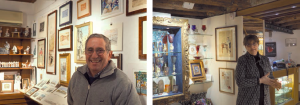VENICE AND ITS GHETTO Stories of Paper and Glass
In the district of Cannaregio, memories chase after one another across the calle where Enzo Aboaf’s shop window reflects its image in Diego Baruch Fusetti’s. “La stamperia del Ghetto” (the Ghetto print workshop) is set not far from Campo di Ghetto Nuovo, in a bright and luminous space dominated by Lele Luzzati’s prints and the antique press, which has fallen out of use for many years. “It has been almost twenty years since we have started this business, we are known all over the world… but lately everything has changed. Some years ago, cruise ships were vital for us: each landing brought crowds of foreign tourists, Americans above all, who came and bought everything they could. Nowadays, our only source of sustenance are basically Luzzati’s printed images”. However, this shop is full of hidden treasures, high-value antique prints that have always been Enzo Boaf’s great passion. His anecdotes are also the outcome of the efforts of a Community, which is alive and active and, at the same time, which is emptied by a demographic decline.
“I was still a little boy… I was twelve or fourteen years old. I started my workshop practice helping the Cesena family in their big gallery to earn some money… My passion for antique prints came from this experience. I don’t even sell some of my prints, and this is not just because there are not buyers anymore!” He opens the big drawers smiling with pride and showing a handful of images. Some of them are faded, marked by the passing years. He alternates the story of the renovation of the workshop – it was a bet hamidrash, then a deposit and finally the Community warehouse, before being completely recovered – with other facts.
“Not even my wife knows this story, but I still remember very well that Ashkenazi woman who had just come down the ship and wanted to buy at any cost the “Moses coming down the Sinai” that was in my showcase. It was very, very expensive. I had brought it from an antiquarian in Padua, and I really liked it. But then came this woman asking me for the price of the print. I tried to discourage her and she pulled out her credit card… What was I supposed to do? We kept on discussing for a while: I hung the image to the wall and she asked me to take it down. In the end, I told her that the only way to pay such a price was in cash, and I was sure I had a close shave. And what did she do, instead? She went behind the corner and she took off her belt, you know, the kind of belt the Americans wear while they are travelling around, and she brought out a roll of banknotes. Oh, it was such a beautiful print… And the Ghetto was crowded, the business was good. Now there are no more shops, butchers or stracciarioli (the ragmen)”. The Ghetto was alive, it was full of people and activities. “Every corner of the ancient Ghetto was beautiful”.
Annamaria Cesana agrees with these opinions. Almost opposite the Stamperia del Ghetto, Cesana and her husband manage Arte Ebraica, a shop which has passed from hand to hand, from a generation to the next. She recovers an item that she particularly loves from the backroom and says: “My parents-in-law were experts at using their hands. They were excellent artisans”. Mosaics by Marco Fusetti are exhibited, but not for sale. Fusetti is practically self-taught, even though he learned the art of mosaics from his professional friends. Another boasting reason for the owner is a clothes and rags-made puppet representing a bearded rabbi, which Cesana recovered for Misses Fusetti. “My mother-in-law Amalia Mariani used to make it and we had a series of rabbis featuring a variety of ritual objects that had a great success. Indeed, they have been the inspiration for the so-called rabbinetti di vetro (little glass rabbis). Their design was studied in detail, and now we sell them too”. They sell them along with a wide range of items made up of different materials, from glass to silver filigree.
However, the family who dedicated his story to handcraft is especially proud of its last creation: “To celebrate the fifth centenary of the Ghetto my husband produced some medals, designed down the finest details. The bronze one, which is the biggest, represents Campo del Ghetto seen from above, whereas the silver ones, the smallest, feature the Cinque Scole façade”.
*This article has been translated by Isabella Favero, student at the Scuola superiore interpreti e traduttori di Trieste, who is doing her apprenticeship in the newsroom of Pagine Ebraiche.

